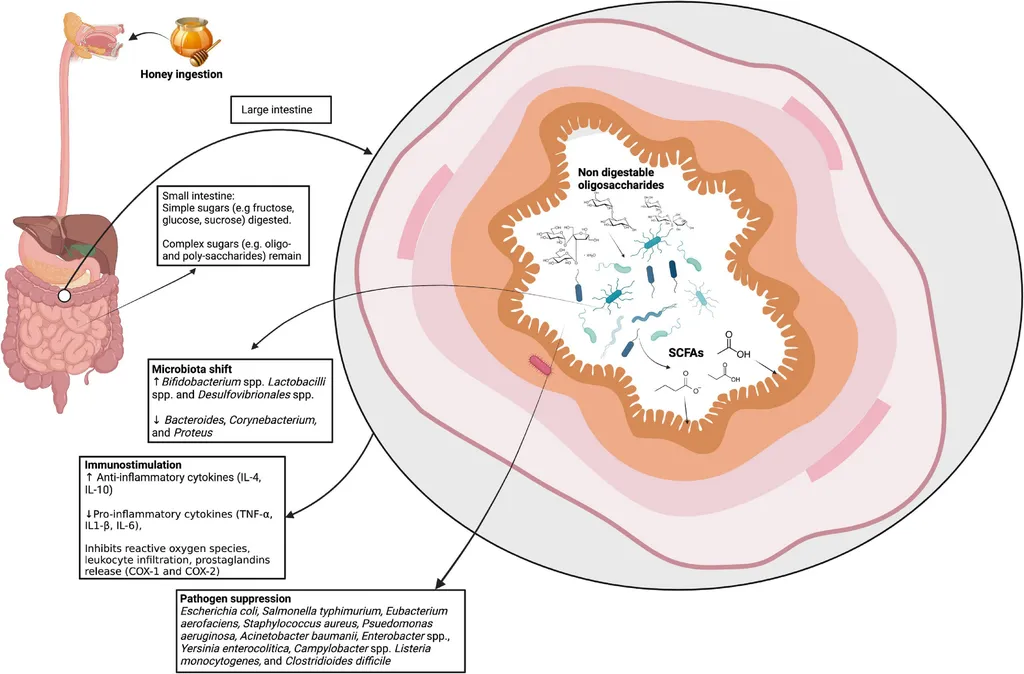In the bustling world of agritech, a groundbreaking discovery has emerged from the intersection of honey and probiotics, with potential implications for the energy sector. Researchers from the College of Food Engineering at Harbin University of Commerce, the Institute of Apicultural Research at the Chinese Academy of Agricultural Sciences, and Jiangsu Hongqi Biotechnology Co. Ltd. have isolated and identified a novel strain of bacteria, Gluconobacter cerinus P-2, from honey, which exhibits remarkable alcohol utilization capabilities.
The study, led by HOU Yuting and colleagues, aimed to isolate probiotics with the ability to utilize alcohol from honey and conduct whole-genome sequencing analysis on the selected strains. The researchers employed a combination of physiological and biochemical tests, 16S rDNA sequencing, and phylogenetic tree construction to identify the isolates taxonomically. They also evaluated the probiotic characteristics of the strains through various tests, including hemolysis, gelatinase activity, nitrate reduction, decarboxylase, antibiotic sensitivity, autoaggregation, and hydrophobicity.
One of the most striking findings of the study was the high autoaggregation capacity of the strain P-2, which was found to be as high as 82.13%. “This is a significant discovery,” said lead author HOU Yuting. “The high autoaggregation capacity of G. cerinus P-2 suggests that it has strong potential for use as a probiotic, as it can form biofilms and adhere to surfaces, which is essential for its survival and activity in the human gut.”
The researchers also found that the strain P-2 was susceptible to several antibiotics, which is a crucial characteristic for a probiotic strain, as it ensures that the strain can be used in combination with antibiotics without compromising their effectiveness. Moreover, the strain showed neither hemolytic nor gelatinase activity, and could not reduce nitrate or decarboxylate amino acids to produce amines, which are all desirable characteristics for a probiotic strain.
Perhaps the most exciting finding of the study was the strain’s ability to utilize ethanol at different concentrations. The researchers found that after 30 minutes of culture at 37 ℃, the utilization rates of 4% and 20% ethanol by 16 mg of G. cerinus P-2 were 61.49% and 36.43%, respectively, which increased to 100% and 63.38%, respectively, after 1.5 hours. “This is a significant discovery,” said HOU Yuting. “The ability of G. cerinus P-2 to utilize ethanol at different concentrations suggests that it has strong potential for use in the energy sector, where ethanol is a major byproduct of many industrial processes.”
The researchers also conducted whole-genome sequencing of the strain P-2, which revealed that the genome size of the strain was 3.17 Mb with an average GC content of 55.62%. Gene ontology annotation indicated that the strain had good metabolic capacity and biofilm-forming capacity, and clusters of orthologous groups of proteins (COG) annotation revealed that the strain had strong transport and metabolic capabilities, without toxic or pathogenic properties and with good autoaggregation properties. Probiotic prediction suggested a probability of over 99% for being a probiotic strain.
The implications of this research are far-reaching, particularly for the energy sector, where ethanol is a major byproduct of many industrial processes. The discovery of a probiotic strain that can utilize ethanol at different concentrations could pave the way for the development of new and innovative technologies for ethanol utilization, which could have significant economic and environmental benefits.
“This is a significant discovery,” said HOU Yuting. “The ability of G. cerinus P-2 to utilize ethanol at different concentrations suggests that it has strong potential for use in the energy sector, where ethanol is a major byproduct of many industrial processes. The development of new and innovative technologies for ethanol utilization could have significant economic and environmental benefits.”
The study was published in the journal Shipin Kexue, which translates to Food Science in English. The researchers hope that their findings will inspire further research into the potential applications of probiotics in the energy sector and beyond. As the world continues to grapple with the challenges of climate change and resource depletion, the development of new and sustainable technologies for energy production and utilization will be essential for ensuring a sustainable future for all.
In the meantime, the discovery of G. cerinus P-2 is a testament to the power of interdisciplinary research and the potential of agritech to drive innovation and progress in the 21st century. As we continue to explore the vast and complex world of microorganisms, who knows what other discoveries await us, and what new and exciting possibilities they may hold for the future of our planet and our species.

